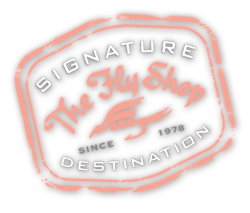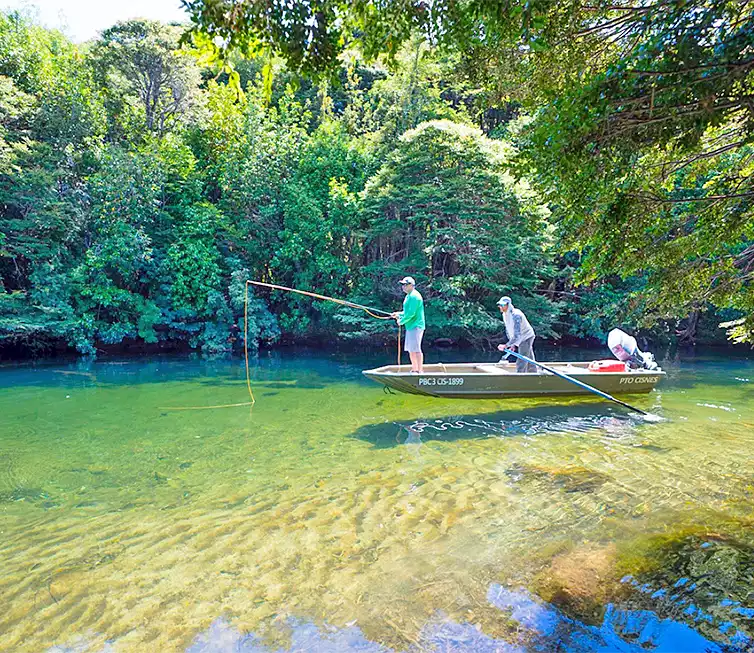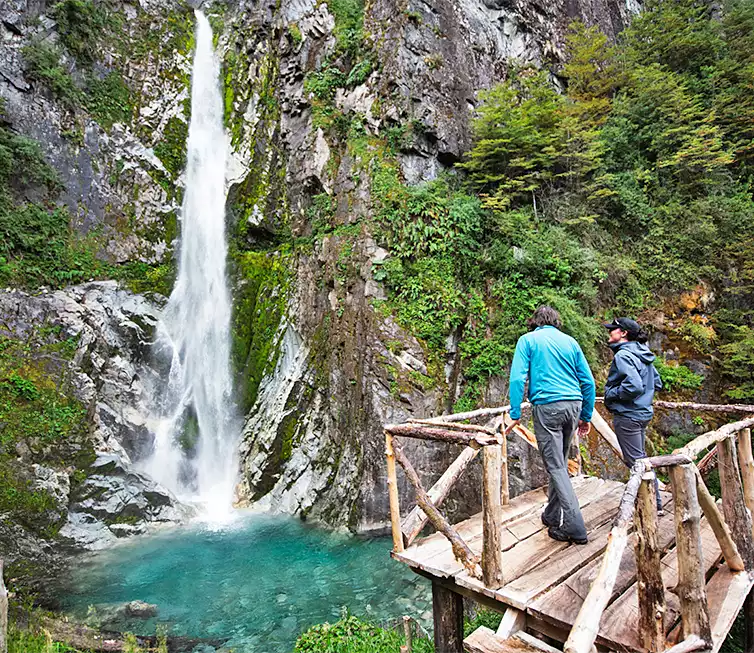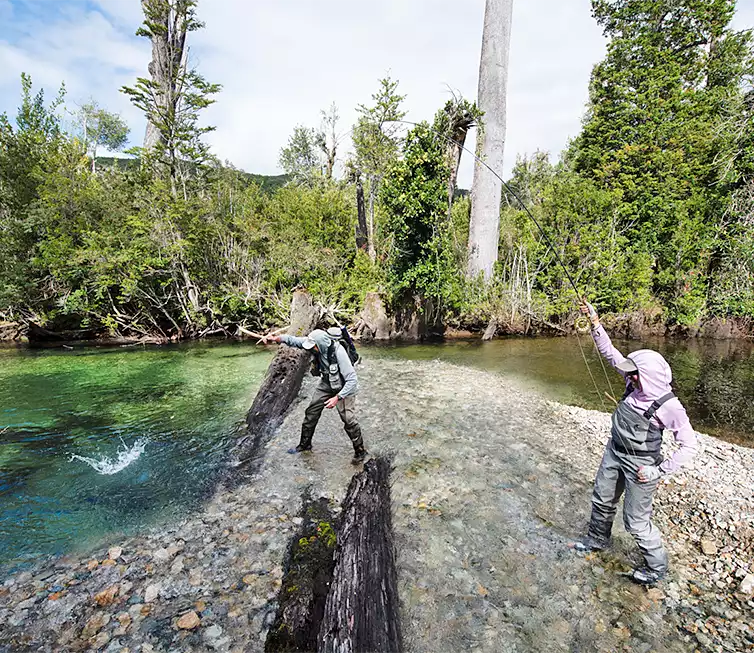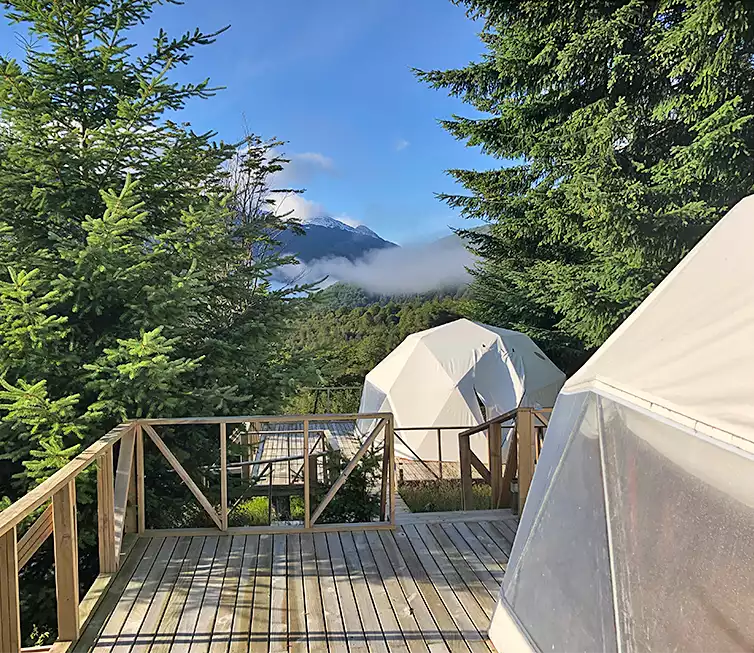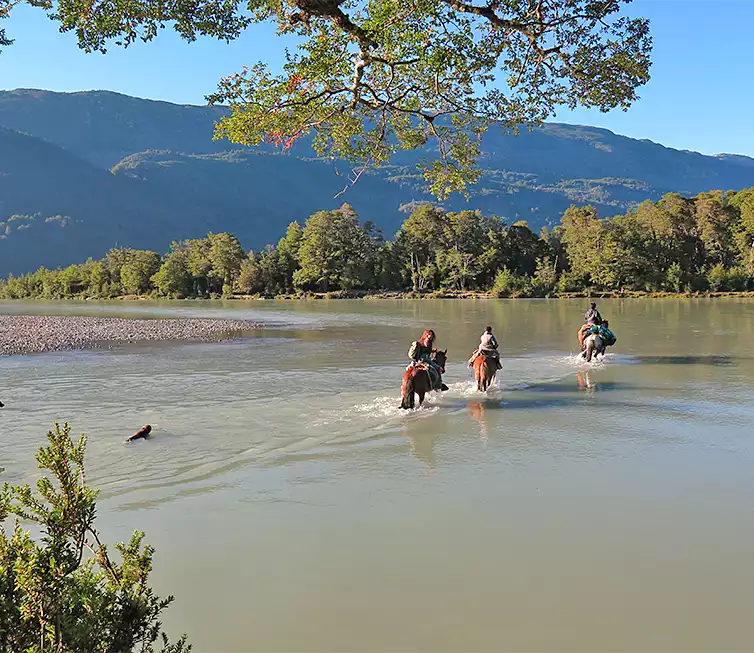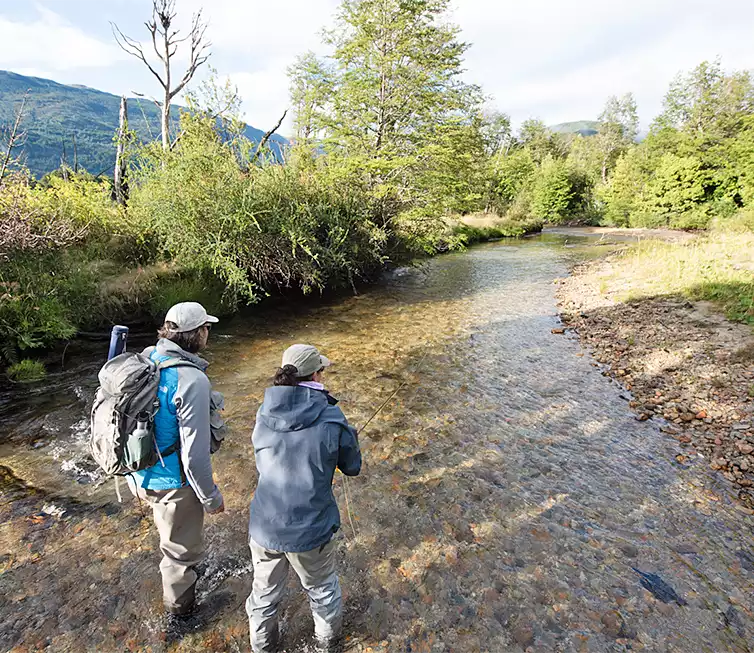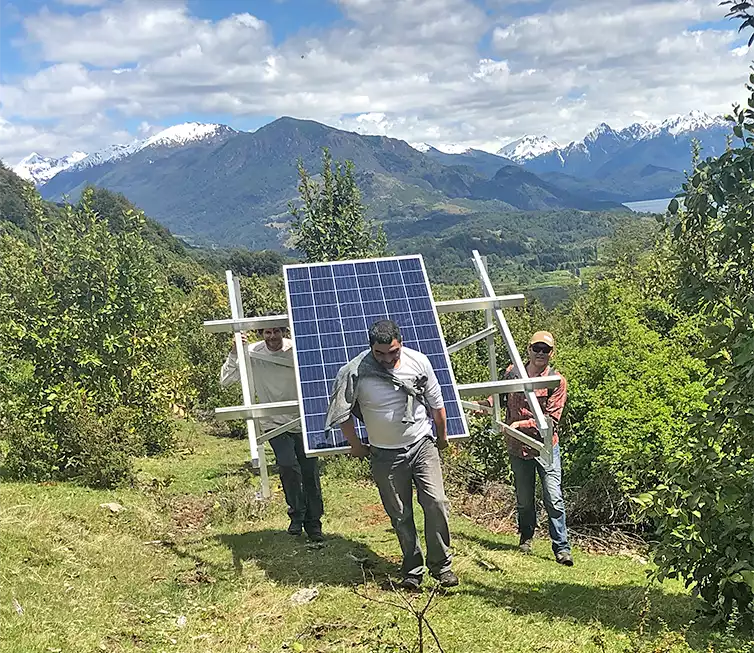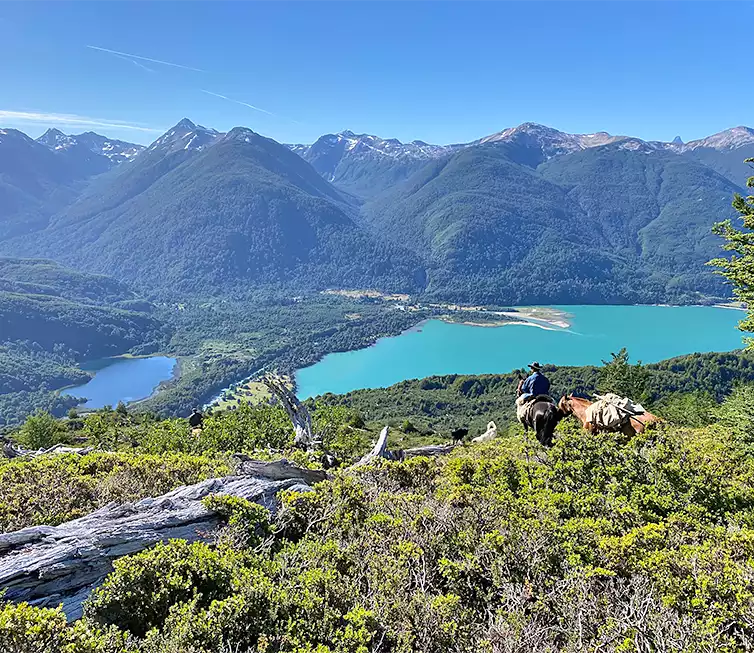This program has been suspended for the time being. Please checkout Patagonian BaseCamp!
Over the past 10 years Marcel Sijnesael, owner of Patagonian BaseCamp, has been acquiring a vast amount of land in the hidden valley of Río Escondido. The Escondido River flows freely from a lake which is itself surrounded by Queulat National Park, a massive 154,093-hectares tract of untouched wilderness. The area is pristine, private and remote, with limited access and zero development. With the help of Chile’s National Park Service (CONAF), Marcel is developing a conservation project and has been able to construct a trail system through virgin forests for access to never-before-seen wilderness and world-class angling.
Marcel and his staff have built a very comfortable camp for a maximum of 4 anglers, total. The camp overlooks an evergreen forest of the Escondido Valley and the turquoise waters of Lago Verde. The views are spectacular, and enjoying a morning coffee on your private deck will be just the start of each adventurous day at Escondido.
Marcel, his guides, and The Fly Shop® embarked on serious exploration of the valley and discovered amazing trout fishing. We caught spectacular wild brown trout up to 30 inches and great numbers of feisty wild rainbow trout. Most often the trout were taken on large dry flies while sight-fishing gin-clear waters. We fished small creeks, larger rivers, small back channels, large lakes, small hidden lagoons, and even under waterfalls – the diversity of the fishery is unparalleled. But there is still much more to explore and we would like to invite a few of our friends to be part of our first official exploratory season.
The Rio Escondido Valley is tucked away in an isolated corner of Chilean Patagonia, close to the Argentina border, and its waters are wild and virtually untouched. The trout you will stalk here will have never seen a fly before and are very cooperative. Access to these waters can be challenging, but for those who are physically fit, have a measure of adventure in their souls and a willingness to go beyond the normal scope of fly fishing…they will be rewarded. Explorers should be prepared for a considerable amount of hiking, bushwhacking, log jumping, river crossing, horseback riding, and remote glamping in complete isolation. You’ll sight-fish crystal clear waters for trophy size trout in virgin territory. It’s not a destination for everyone, but if you are game for a truly unique experience and want to be the first, Escondido is the wilderness fly fishing adventure you have been looking for. We couldn’t be more bullish on this unique, once-in-a-lifetime opportunity, all orchestrated by Marcel and his talented team of guides and staff at Patagonian BaseCamp.
There is a maximum of eight El Escondido weeks being offered for a maximum of 4 anglers per week, January 14 through March 10, 2024. Space is limited for a reason, to keep this fishery as wild and fresh as when we discovered it.
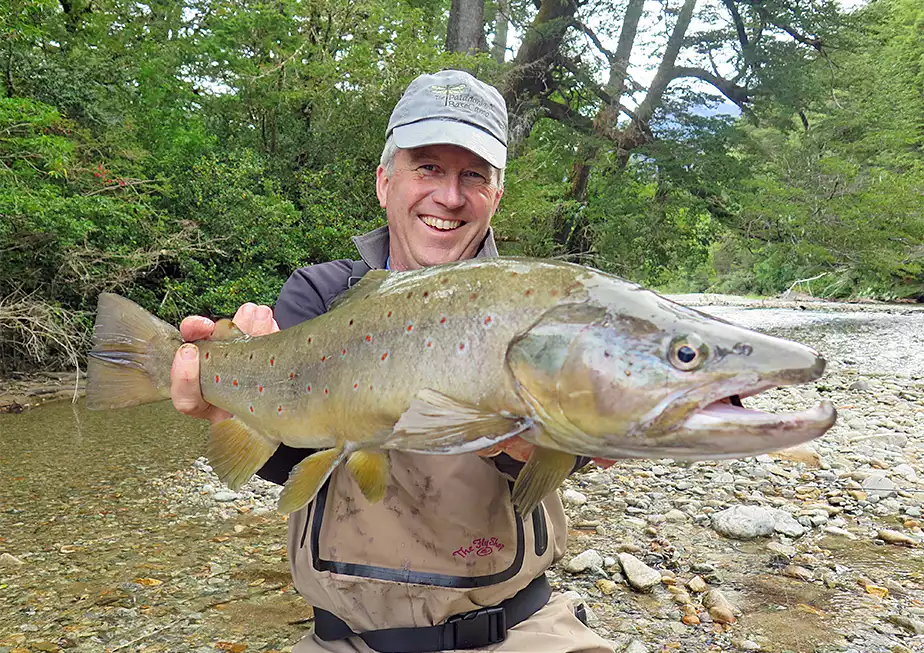
Reservations & Rates
7 nights / 6 days of fishing program - Sunday to Sunday - USD $6,990 per person, double occupancy
(4 anglers maximum per week)
Inclusions
Your angling package at El Escondido includes Meet and greet at Puerto Montt´s Tepual airport and transfer to La Paloma airport followed by a charter flight to La Junta, Chaiten or Lago Verde , and return flight from La Junta, Chaiten or Lago Verde to Puerto Montt´s Tepual airport (subject to weather conditions) / lodging at Escondido based on double occupancy / fishing license / flies / daily guided fishing excursions based on an angler to guide ratio of 2:1, all meals, drinks.
Non-Inclusions
Other non-inclusions are possible extra lodging, transfer, travel expenses or trip modifications as result of a delay, either planned or requested by the guest or as a result of an act of God. Fishing equipment, like waders, rods, lines, etc.
Travel Insurance
The Fly Shop® is not in the insurance business, but we recommend Travel Guard coverage as a service with a desire to see your best interests protected. It is impossible to know when an unfortunate situation (loss of luggage, fly rods, illness in the family, or an accident) may occur. However, such things can and do happen, and this insurance can provide a means of recourse against non-refundable financial losses.
• Travel Insurance Information
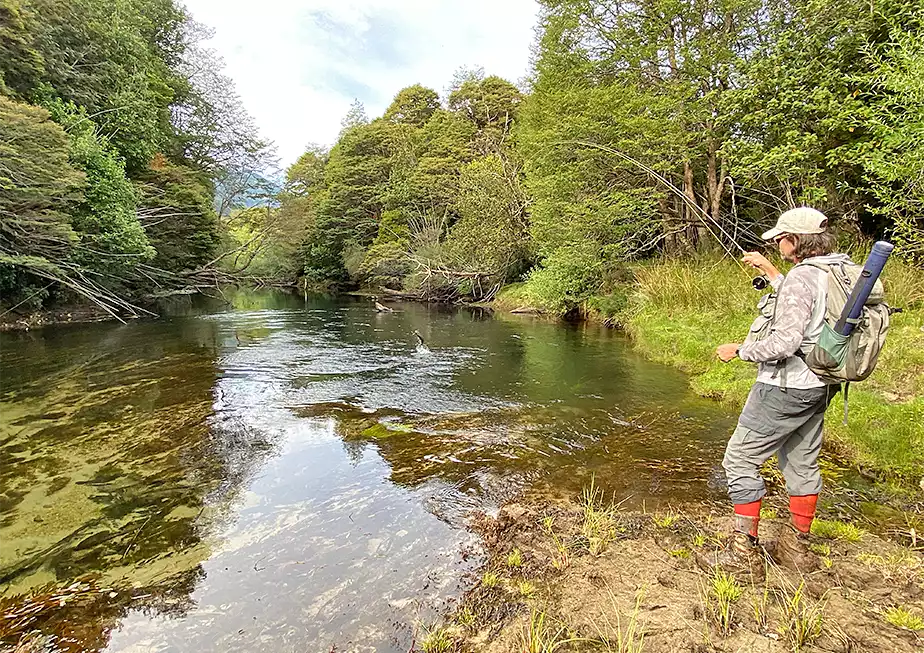
Seasons at El Escondido
The season at El Escondido is short, typically spanning the months of January and February, into early March. Because of this there are no shoulder weeks...every week of the season is dead center in prime fishing time.
Read More
Trout season in Chilean Patagonia swings into high gear by the New Year, and continues until leaves turn crimson and drop with the arrival of winter, in late April. The summers of Patagonia are abbreviated, much like those of Montana and Wyoming. Warm days often begin with cool mornings and can be punctuated by sudden thunderstorms. But for the most part, the best time to visit this fantastic part of the world is from mid-December through early April.
Their January is our July. Spring snow melt is gone, the weather’s reliable, temperatures are pleasant, and the hatches are predictable. This is a great time for fishing dry flies. There is a wonderful golden stone fly hatch that keep trout looking up and keyed in on this big meal.
By the first of February trout begin to key on terrestrials like stag beetles, ants and other terrestrials that dominate mid-summer fly fishing action. Probably because of the weather, February and March are the most popular months to travel to and fish Patagonia. Too, our winter is a great time to escape to Patagonia’s summer and trout fish for a week or so; something difficult to do when Michigan or Vermont is frozen solid.
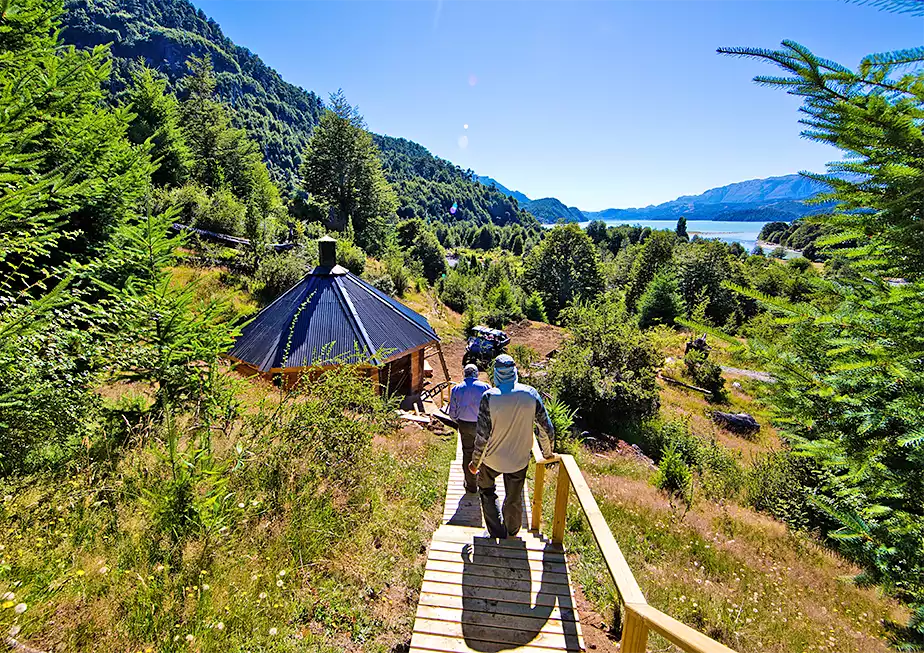
Getting to El Escondido
ARRIVAL DAY
On the morning of your trip’s start date, you will be met by a representative of Escondido as you arrive to the Puerto Montt Airport from Santiago – remember you need to arrive Puerto Montt no later than 10:00 AM. This representative will help with your luggage, load you into their vehicle, and drive you immediately to the charter airport to catch the charter flight to either La Junta Chaiten or Lago Verde (depending on where Marcel has decided to fly guests that morning). All arrangements have been made in advance for you once you arrive at the Puerto Montt airport, and the check-in procedure is swift and easy. The charter flight itself is approximately 40 minutes and flies over a stunningly beautiful and rugged landscape. Keep your cameras out and ready!
Read More
Maximum allowed baggage weight is 45 pounds…if you must bring more luggage, the charter flight operator will charge you for the extra overweight, on site, at about $1.50/pound (US dollars or credit cards are acceptable to use for these charges). If necessary, the lodge can arrange for excess luggage to be stored safely at the charter airline office at no cost.
Upon arrival to the airstrip at La Junta, Chaiten or Lago Verde (determined by weather) you will be met by Marcel Sijnesael or a representative of the lodge and transferred via vehicle and boat to El Escondido, with a stop at the Temple Camp for lunch. The scenic drive follows the famous Careterra Austral, and the Southern Highway. Eventually you’ll come to a large lake, where a powerboat will be waiting to take you across the lake to the camp. Just in front of the camp a river flows, and you are welcome to wander down to the water in search of your first Patagonian trout of the week. If, however, you would like to relax from your journey, the pisco sours (typical Chilean cocktail) will be cold and the crew will help you get settled! A wonderful dinner – the first of many to come – is served at approximately 8:00 p.m.
THE ANGLING WEEK
Being blessed by numerous rivers, creeks, and a great lagoon, the angling options are quite varied. The fishing program will be designed to your personal preferences, but always taking into consideration the prevailing weather and river conditions. Some of the most popular options include hiking the trail Marcel has built over a couple of years that accesses the home river, Rio Escondido; fishing some of the numerous small side channels and tributaries of this river; jet boating the Rio Turbio to access miles of fished filled runs and riffles; and floating the nearby laguna that is packed with dry fly eating brown trout.
Breakfast and dinner are served in the camps dining facility, and fine mid-day meals are served streamside. The after-angling cocktail reception always includes pisco sour (the Chilean version of a margarita), and fine domestic wines. Dinners, like all meals at the camp, are informal, superb, and accompanied by the finest Chilean wines.
Day 2, 3, 4 and day 5 - fishing out of El Escondido Camp - all access by boat or walking/hiking.
Day 6 - transfer across Lago Verde to Temple Camp, fishing, Rio Pico (wading), Cacique Blanco (wading) or floating upper Temple into the Temple Camp – lodging at the Temple Camp
Day 7 - Fishing out of Temple Camp (Upper or Lower Temple Float or wading Rio Pico)
Day 8 - Sunday - depending on weather conditions PM arrival at La Junta, Chaiten or Lago Verde airstrip for charter flight back to Chaiten. Connection from Puerto Montt to Santiago to be booked after 4:00 PM
DEPARTURE DAY
After breakfast, you will be transferred back to the airstrip at La Junta, Chaiten, or Lago Verde for your flight back to the Paloma airport. From there you’ll be transferred back to the Puerto Montt airport and onward connections. Connection from Puerto Montt to Santiago to be booked after 4:00 PM
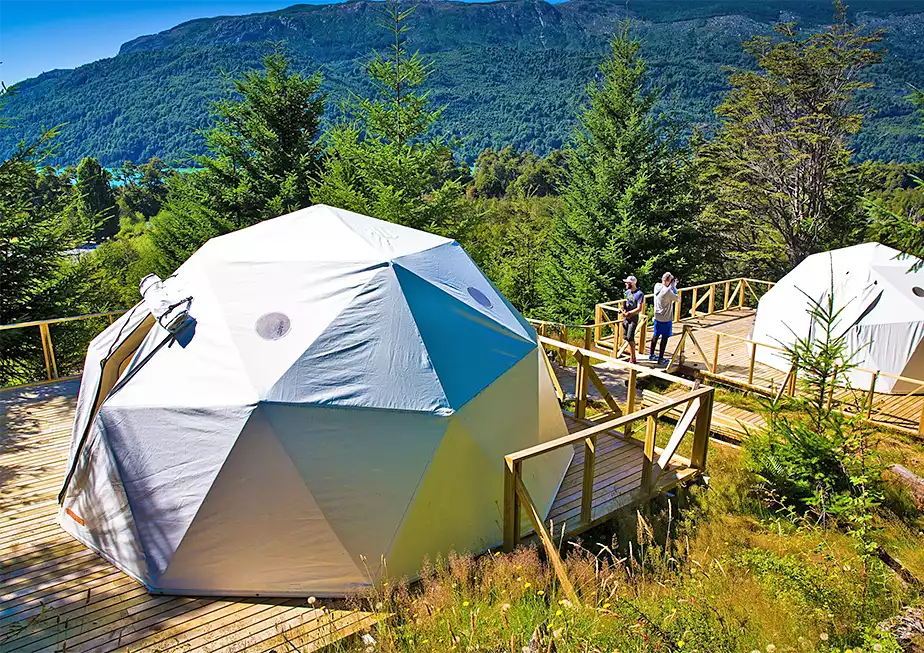
Lodging at El Escondido
The Spanish word “Escondido” means “hidden” in English. And hidden it is. The Río Escondido finds its source in a 3 kilometers long lake called “Laguna Escondida”. Over the course of 8 kilometers the river flows as a free stone wilderness river through virgin evergreen forests before it joins the glacier fed river called “Rio Turbio” and the smaller creek of “El Salto”. Only a kilometer further downstream their waters drain into the much larger lake of “Lago Verde”. The camp can only be reached by a 20 minute boat ride crossing “Lago Verde” or by an adventurous 3 hour horseback ride along its banks. Exclusivity is guaranteed.
Read More
On one of the hills, at the junction of the three rivers, overlooking the virgin forests of the valleys and the turquoise water of Lago Verde, is built a camp for 4 guests. 3 large dome-shaped tents are built on wooden platforms which are connected by boardwalks. Each “domo tent” can sleep two guests. An open-wall “quincho” forms the dining area where meals are prepared on an open fire.
It’s all a wilderness experience. Electricity and hot water for the showers is generated by solar power.
Your daily fishing adventures start right at the camp with various options just a short walk away. Some days you just will leave on foot, on other days by horseback and on yet others by boat or raft.
The camp forms a part of our larger Escondido project. A conservation initiative of The Patagonian BaseCamp and supported by visiting anglers and others interested in a unique wilderness outdoor experience.
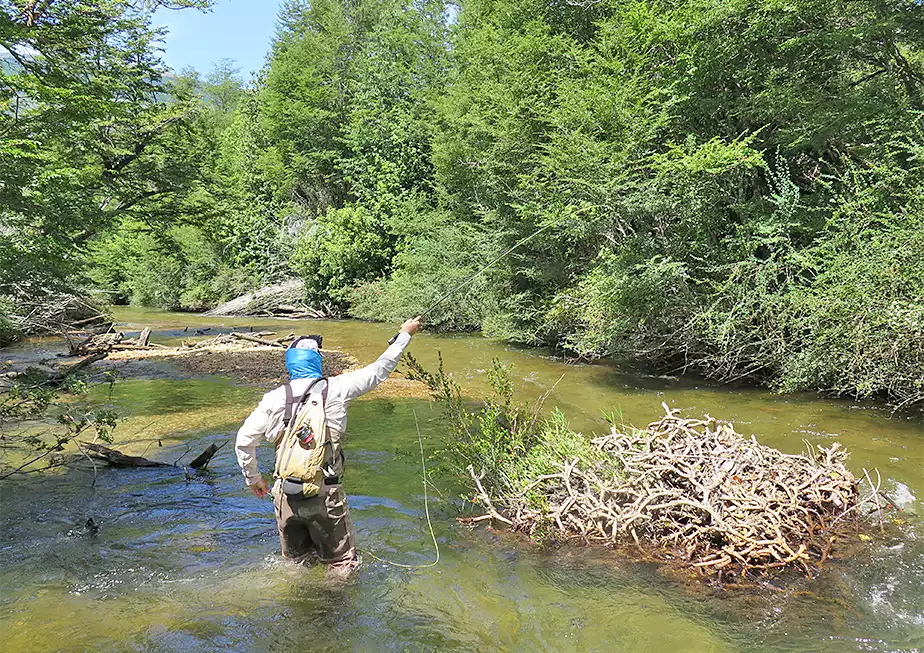
Fishing at El Escondido
The Rio Escondido Valley is tucked away in an isolated corner of Chilean Patagonia, close to the Argentina border, and its waters are wild and virtually untouched. The trout you will stalk here will have never seen a fly before and are very cooperative.
Access to these waters can be challenging, but for those who are physically fit, have a measure of adventure in their souls and a willingness to go beyond the normal scope of fly fishing...they will be rewarded. Explorers should be prepared for a considerable amount of
Read More
hiking, bushwhacking, log jumping, river crossing, horseback riding, and remote glamping in complete isolation.
You’ll sight-fish crystal clear waters for trophy size trout in virgin territory. It’s not a destination for everyone, but if you are game for a truly unique experience and want to be the first, Escondido is the wilderness fly fishing adventure you have been looking for. We couldn’t be more bullish on this unique, once-in-a-lifetime opportunity, all orchestrated by Marcel and his talented team of guides and staff at Patagonian BaseCamp.
Why We Endorse This Destination:
El Escondido
• The lodge is located in a very remote and visually spectacular part of Chilean Patagonia; you will fish daily on waters that get NO outside pressure, (it’s all private property) in jaw-droppingly beautiful surroundings. Such little pressure on the fisheries assures guests of ample opportunities to cast dry flies over happy and hungry trout.
• El Escondido is newly built and comfortable wilderness outpost camp on numerous rivers, lagoons and lakes in relative luxury far from any civilization. Guests can experience true Patagonia wilderness solitude without sacrificing the creature comforts of a world-class wilderness camp, including hot showers and 24 hour electricity.
• Marcel has spared no expense acquiring the finest (largely Rocky Mountain) guide staff in Chile; along with his impressive fleet of cata-rafts, rafts, jet boats and drift boat, guests get the benefit of a familiar guide experience, located in an exciting, untouched locale. Anglers will learn techniques from these guides that will serve them in trout waters anywhere in the world, and never experience a communication challenge with their guide!
• At El Escondido expect small water fishing on freestone rivers, spring creeks, lagunas and lakes. Expect spot and stalk fly fishing (New Zealand style) in gin clear waters with not another soul in sight. If you like hunting trout in true solitude, Escondido is perfect for you.
• The El Escondido Project is coordinated and fully supported by Marcel Sijnesael owner and operator of Patagonian BaseCamp and has talented staff. You can rest assure that every single facet of your trip will be well looked after and no stone left unturned to make sure this adventure is a world-class trip. All you have to think about is enjoying your adventure, Marcel and his team will look take care of all the details.
